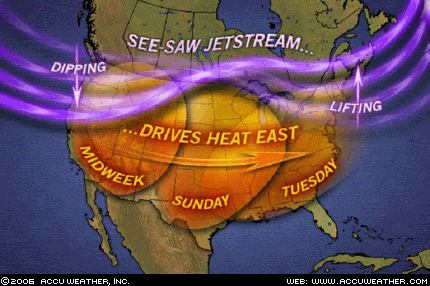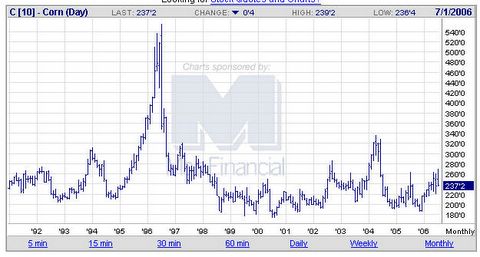A Big Squeeze On Farmers
Mish Moved to MishTalk.Com Click to Visit.
The Associated Press is reporting More than 60 percent of U.S. in drought.
More than 60 percent of the United States now has abnormally dry or drought conditions, stretching from Georgia to Arizona and across the north through the Dakotas, Minnesota, Montana and Wisconsin, said Mark Svoboda, a climatologist for the National Drought Mitigation Center at the University of Nebraska at Lincoln.Here is a picture of that corn. It is not a pretty sight.
An area stretching from south central North Dakota to central South Dakota is the most drought-stricken region in the nation, Svoboda said.
"It's the epicenter," he said. "It's just like a wasteland in north central South Dakota."
Conditions aren't much better a little farther north. Paul Smokov and his wife, Betty, raise several hundred cattle on their 1,750-acre ranch north of Steele, a town of about 760 people.
Fields of wheat, durum and barley in the Dakotas this dry summer will never end up as pasta, bread or beer. What is left of the stifled crops has been salvaged to feed livestock struggling on pastures where hot winds blow clouds of dirt from dried-out ponds.
Some ranchers have been forced to sell their entire herds, and others are either moving their cattle to greener pastures or buying more already-costly feed. Hundreds of acres of grasslands have been blackened by fires sparked by lightning or farm equipment.
"These 100-degree days for weeks steady have been burning everything up," said Steele Mayor Walter Johnson, who added that he'd prefer 2 feet of snow over this weather.
Farm ponds and other small bodies of water have dried out from the heat, leaving the residual alkali dust to be whipped up by the wind. The blowing, dirt-and-salt mixture is a phenomenon that hasn't been seen in south central North Dakota since the Dust Bowl of the 1930s, Johnson said.

The question is: Is that a representative picture of the corn belt or not?
I remember the hype last year when we had what seemed to be a similar heat wave, yet corn crops produced a near record yield. On the other hand, whatever farmer has corn that looks like that is without a doubt in trouble.
The Heat Dome
Here are a couple of pictures of that Heat Dome followed by what is supposedly "relief".
Bear in mind that these pictures are as of Sunday evening.
Things may change by the time this is posted.



The above images thanks to AccuWeather.
As of Sunday evening we see "relief is on the way". But "relief" is relative. In my area (Crystal Lake Illinois NW of Chicago) temperatures are expected to soar to 101 on Monday. Later in the week they will fall to the mid 80's. Is that relief? Certainly 84 is better than 101 but I am not sure that really constitutes "relief". Will farmers feel relieved?
Killer Heat Waves
The associated press is reporting Better get used to killer heat waves.
In Fresno, the morgue is full of victims from a California heat wave. A combination of heat and power outages killed a dozen people in Missouri. And in parts of Europe, temperatures are hotter than in 2003 when a heat wave killed 35,000 people.One might think that with corn crops looking like the above picture, and with weather patterns showing 60% of the US in drought that corn prices might be soaring.
Get used to it.
For the next week, much of the nation should expect more "extreme heat," the National Weather Service predicts.
In the month of August, most of the United States will see "above normal temperatures," forecasters say. For the long-term future, the world will see more and worse killer heat waves because of global warming, scientists say.
The July burst of killer heat waves around the world can't be specifically blamed on global warming. And they aren't the worst ever, they still can't quite hold a melting candle to the scorching heat of America's 1930s Dust Bowl. But the trend is pointed in that direction, experts say.
Heat waves and global warming "are very strongly" connected, said Kevin Trenberth, climate analysis branch chief at the National Center for Atmospheric Research in Boulder, Colo. The immediate cause of the California heat wave and other heat waves is day-to-day weather, he said.
"These (heat) events always occur. What global warming does is push it up another notch," Trenberth said.
And the computer models show that soon, we'll get many more and hotter heat waves that will leave the old Dust Bowl records of the 1930s in the dust, said Ken Kunkel, director of the Center for Atmospheric Sciences at the Illinois State Water Survey.
Far from it. Here are two charts of corn prices.
The first chart is the futures price of September 2006 corn.
The second chart is a continuous chart of corn prices back to 1991.
September 2006 Corn Futures

Corn prices 1991 - 2006

It is interesting to note that corn prices are back to 1991 levels. If I could go back further you would see that corn prices are close to 1943 levels. This "commodity bull" sure has not been spread very evenly. In fact if you look you will see that it is nearly totally energy and metals related. Other than sugar, most food stuff has been left in the dust.
Certainly corn yields and farmer productivity have soared. It takes one tenth the number of farmers to grow the same number of crops as it did 20-30 years ago. How much more productivity can we expect? Once corn is as drought resistant as last year's hybrids proved to be, what is the next step? Perhaps the next step is coming soon. Then again, perhaps that step will not come for another 15 years.
At the very least one might expect at a decline in the rate of farm productivity if not an out right collapse of it. Yet I look around at fertilizer costs, at crude costs (those plows are not powered by solar energy, not yet anyway), and I see a big time squeeze on farmers. Even with all this hype on corn produced ethanol, corn prices have collapsed right into a heat wave with energy prices headed to the moon no less.
Ethanol
Recently Brazil offered to sell the US ethanol at prices 35 cents a gallon cheaper than going US rates. We turned them down. Oddly enough the entire country, including farmers, is paying more for energy than they might have to if we would take Brazil up on their offer.
Price crop supports are a large part of the problem. If we did not have crop supports corn, beans, wheat, and sugar would only be grown where it was economical. Yet we have a sugar lobby that allows sugar to be grown where it makes no economic sense, and so on and so forth for rice, oranges, corn and even tobacco.
No doubt US farmers everywhere liked the tone of the first half of this article better than the last couple of paragraphs but I am going to continue anyway. As long as the government guarantees price crop supports we will produce more crops than we can use. Those crops will be then be dumped on the global market suppressing emerging markets. Those emerging markets will have less money to buy other US goods and services.
There is nothing sacred about the "Small American Farm". Why should farmers be signaled out for income support as opposed to computer programmers, homebuilders, or writers? Hmmm. Of that group, writers and computer programmers receive no subsidies although farmers and homebuilders do. Where is my subsidy?
The answer is not to give writers or computer programmers a guaranteed living but rather not to give subsidies to anyone.
Most subsidies do not go to small farmers anyway. The vast majority of subsidies goes to huge conglomerates. If we did not provide cheap subsidized water as well as price crop supports to water the desert in California and other places, perhaps farmers in Illinois, Wisconsin, Iowa, and Indiana could make a better go at things, without taxpayer subsidies.
Not only are price crop supports costing the US government plenty of dollars, they are also hurting states that should have a natural competitive advantage because of a better growing climate and better soil. In the current environment, everyone loses except for the marginal producer receiving unjust and unwarranted crop supports and water subsidies. It makes no sense to water the desert in California to produce onions or other produce when they can be produced far cheaper elsewhere with no subsidies.
Water Resources
The Baltimore Chronicle is reporting World's Water Resources Face Mounting Pressure.
July 26, 2006--Global freshwater use tripled during the second half of the twentieth century as population more than doubled and as technological advances let farmers and other water users pump groundwater from greater depths and harness river water with more and larger dams. As global demand soars, pressures on the world’s water resources are straining aquatic systems worldwide. Rivers are running dry, lakes are disappearing, and water tables are dropping. Nearly 70 percent of global water withdrawals from rivers, lakes, and aquifers are used for irrigation, while industry and households account for 20 and 10 percent, respectively.Does it make any economic sense to water the California desert to grow onions, lettuce, corn or whatever? I think not. Of course water rights holders in the Western states would disagree. After all, who wants to give up a free handout? Yet the economic benefit to California would likely be huge if those water rights and crop subsidies were scrapped. There would not be a huge need for illegal aliens to pick those crops, individual homeowner water bills would drop, and water tables would have a chance at recovery.
Pressure on water resources is particularly acute in arid regions that support agricultural production or large populations—regions where water use is high relative to water availability. The Middle East, Central Asia, North Africa, South Asia, China, Australia, the western United States, and Mexico are especially prone to water shortages.
The first major country that has the balls to go completely 100% to free market concepts without crop or water (or for that matter ANY subsidies) will be a big winner regardless of what any other country does. Yes, there will be short term pain but there will be long term gain. The long term gain will come from cheaper, more competitive prices for all goods and services. Small business will flourish in that environment. Instead we pay lip service to the idea of "free trade".
Free Trade vs. Protectionism
I fear that governmental policies will build fences not roads, build barriers instead of bulldozing them, and support intervention and manipulation over free enterprise. The recent collapse of the world trade talks is telling. Every year expectations build and every year either the US or Europe manages to sabotage them. This has been going on for as long as I can remember.
I have said this before and I will say it again. Protectionism and trade wars are a hallmark of deflationary times. Yes, farmers are squeezed but a huge part of the reason is the silly economic and political policies of the US.
Mike Shedlock /Mish
http://globaleconomicanalysis.blogspot.com/



